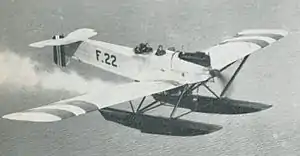Hansa-Brandenburg W.33
Hansa-Brandenburg W.33 was a German two-seat, low-wing single-engined seaplane, which had been designed by Hansa und Brandenburgische Flugzeugwerke during World War I. Although the W.33 was built in relatively small numbers, the design was widely recognized as successful and numerous copies and license built versions were built by the hundreds after World War I.
| W.33 | |
|---|---|
 | |
| Role | Reconnaissance seaplane |
| Manufacturer | Hansa und Brandenburgische Flugzeugwerke |
| Primary users | German Imperial Navy Finnish Air Force |
History
The Hansa-Brandenburg W.33 aircraft was designed in 1916 by Ernst Heinkel and entered German service in 1918. 26 aircraft were built of this design, but only six before the collapse of the German empire. Noticeably superior to the FF.33L, it proved to be an excellent aircraft. The Hansa-Brandenburg monoplanes considerably influenced German seaplane design; several copies appeared in 1918, such as the Friedrichshafen FF.63, the Dornier Cs.I, the Junkers J.11, and the L.F.G. Roland ME 8. After the war a version of the W.29 was used by Denmark, while Finland obtained a license for to manufacture of the W.33.
Finland purchased a number of W.33 and W.34 aircraft from Germany. In 1921, Finland also obtained the manufacturing license for the W.33. The first Finnish-built Hansa made its maiden flight on 4 November 1922, and was called IVL A.22 Hansa. This aircraft was the first industrially manufactured aircraft in Finland. During the following four years a total of 120[1] aircraft were manufactured. This aircraft would become the second most numerous aircraft that had been built in Finland for the Finnish Air Force through the ages (the PIK-20 gliders had been manufactured in greater amounts in the 1970s).
The Finnish Air Force used the aircraft in maritime service until 1936.
Variants
- Hansa-Brandenburg W.33
- 26 built.
- IVL A.22 Hansa
- Finnish license manufactured W.33, 120 built.
- Yokosuka Navy Type Hansa Reconnaissance Seaplane
- Approximately 310 aircraft directly derived from the W.33, built by Nakajima and Aichi for the Imperial Japanese Navy[2]
Operators
- Kaiserliche Marine (Marinefliegerkorps)
Survivors
There is one Hansa in the Finnish Aviation Museum.[1]
Specifications (W.33 / Msn.2543)
Data from Hansa-Brandenburg : Aircraft of WWI Volume 3, Monoplane Seaplanes [3]
General characteristics
- Crew: 2
- Length: 11.1 m (36 ft 5 in) ~
- Wingspan: 15.85 m (52 ft 0 in)
- Height: 3.3 m (10 ft 10 in)
- Wing area: 43.5 m2 (468 sq ft)
- Empty weight: 1,420 kg (3,131 lb)
- Gross weight: 2,050 kg (4,519 lb)
- Powerplant: 1 × Maybach Mb.IVa 6-cylinder water-cooled in-line piston engine, 183 kW (245 hp)
- Propellers: 2-bladed fixed-pitch propeller
Performance
- Maximum speed: 173 km/h (107 mph, 93 kn)
- Cruise speed: 154 km/h (96 mph, 83 kn)
- Time to altitude: 1,000 m (3,281 ft) in 5 minutes 24 seconds
- 2,000 m (6,562 ft) in 12 minutes 48 seconds
- 3,000 m (9,843 ft) in 22 minutes 18 seconds
Armament
- Guns: 2x fixed forward-firing machie-guns adjacent to the cockpit and a 20 mm (0.787 in) Becker Type M2 cannon on a gun ring in the rear cockpit (fitted to msn.2538)
Avionics
a radio was carried on some aircraft
References
- Owers, Colin A. (January 1998). "Zeebrugge's Hornets: the Brandenburg monoplanes". Air Enthusiast. January/February 1998 (73): p.p.58-62.
- Mikesh, Robert; Shorzoe, Abe (1990). Japanese Aircraft 1910-1941. London: Putnam. ISBN 0-85177-840-2.
- Owers, Colin A. (2015). Hansa-Brandenburg : Aircraft of WWI Volume 3, Monoplane Seaplanes. USA: Aeronaut books. pp. 66–123. ISBN 9781935881339.
Further reading
| Wikimedia Commons has media related to Hansa-Brandenburg W.33. |